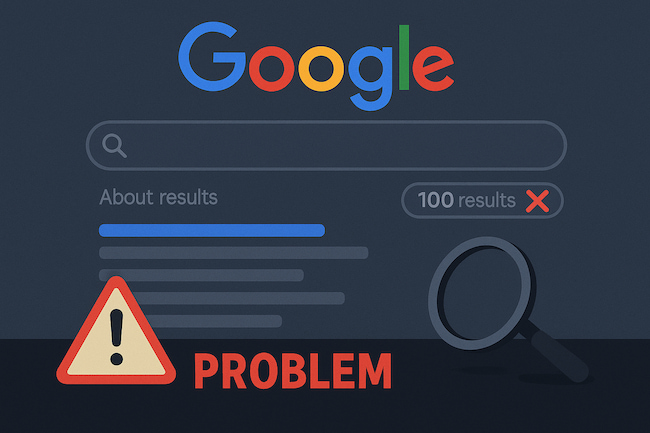Google Removes Deep Search Pagination
Why You Can No Longer See 100 Results per Page
In 2025, Google quietly ended a long-standing feature that power users, researchers, and SEOs had relied on for decades: the ability to view up to 100 search results per page.
This removal affected both:
-
The manual “Search settings” control that let users choose to show 10–100 results per page, and
-
The
&num=100URL parameter that overrode default pagination.
Together, these changes eliminated deep browsing beyond roughly the top 40–60 results, marking a fundamental shift in how Google delivers information and how deeply users can explore the index.

1. What Changed
a. The Old “Search Settings” Control
Until recently, users could go to Settings → Search settings → Results per page and select how many results to display — up to 100 at a time.
That control has now disappeared for most users globally.
The slider is gone, and Google’s interface defaults to 10 results per view, loaded dynamically through continuous scrolling (which began rolling out on desktop in December 2022).
Even when users scroll, the system loads data in small batches rather than as one unified 100-result page — effectively enforcing the same limitation under a new UI.
b. The &num=100 Parameter
For years, power users and SEO professionals added the &num=100 parameter to URLs (for example:
https://www.google.com/search?q=example&num=100)
to request 100 results per page directly.
In September 2025, Google confirmed to Search Engine Land and Search Engine Journal that it no longer supports the num parameter.
“The
numparameter is not something we officially support,” a Google spokesperson told Search Engine Land.
“Behavior may vary and should not be relied upon.”
As a result, even if the parameter is present, Google now ignores it, capping each visible set of results to the default small batch size.
2. Why Google Made This Change
a. Performance and Resource Efficiency
Rendering and transmitting 100 results per request consumes far more bandwidth and compute time. With billions of queries per day, that extra load was measurable at scale. Limiting output to smaller chunks allows for faster perceived load times and less strain on infrastructure.
b. Anti-Scraping and Data Protection
The 100-result views (both setting and URL parameter) were heavily used by SEO crawlers, academic researchers, and large-scale scrapers. Removing the feature makes automated bulk data collection harder and slows down rank extraction.
c. Relevance and Ranking Stability
Deep pages (beyond ~50 results) were rarely useful and often contained duplicates, spam, or low-relevance results. Limiting exposure allows Google to prioritize showing only stable, higher-quality listings.
d. User Experience and Behavior Data
Internal research shows over 99% of users never go past page 3. Maintaining infrastructure for pages 10–100 served almost no one. Infinite scroll better fits modern expectations, especially on mobile.
e. Strategic Shift Toward AI and Summarization
Google’s AI Overviews (SGE) and continuous scroll reflect a philosophical change: users shouldn’t need to comb through hundreds of results — the system should summarize, interpret, and answer directly. Deep pagination doesn’t align with that model.
3. Effects and Industry Impact
a. SEO Tools and Rank Trackers
-
Rank-tracking platforms that relied on
&num=100must now issue 10× more queries to gather equivalent data, driving up cost and rate-limit exposure. -
Many tools (Ahrefs, Semrush, AccuRanker, etc.) have reduced tracking depth or switched to sampling models.
b. Google Search Console Metrics
-
Site owners report noticeable drops in impressions and changes in “average position.”
-
This is because automated tracking queries previously inflated impressions; with deep-page access restricted, bot-driven hits no longer count.
c. Research and Transparency
-
Academics and investigative journalists lose the ability to easily explore beyond page 10–20.
-
It becomes harder to verify whether pages are indexed but deeply buried.
d. User Confusion
-
Many users believe the feature is “buggy” rather than discontinued, since Google has not provided a formal public-facing notice — only confirmations via SEO media outlets.
4. Community and Media Coverage
| Source | Reported Topic | Key Takeaway |
|---|---|---|
| Search Engine Land (Sept 2025) | Official Google confirmation | Google “does not support” the num parameter |
| Search Engine Journal (Sept 2025) | Impact on SEO tools | Rank tracking disrupted; metrics shifting |
| Search Engine Roundtable | Community reports | Widespread loss of 100-result capability |
| Seobility Blog | Technical analysis | Anti-scraping and infrastructure motives |
| 42Works (2025) | Broader UX change | Aligns with infinite scroll and AI integration |